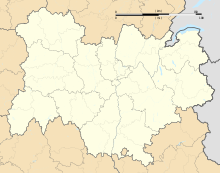Gouffre Mirolda
Appearance
This article has been translated from a Wikipedia article in another language, and requires proofreading. |
You can help expand this article with text translated from the corresponding article in French. (May 2020) Click [show] for important translation instructions.
|
| Gouffre Mirolda | |
|---|---|
| Location | Samoëns, France |
| Coordinates | 46°05′21″N 6°46′15″E / 46.08917°N 6.77083°E |
| Depth | 1,733 metres (5,686 ft) |
| Length | 13,000 metres (43,000 ft) |
| Elevation | 1,880 metres (6,170 ft) |
| Discovery | 1971 |
Gouffre Mirolda is a karstic cave located in the Haut-Giffre mountain range, in the commune of Samoëns, Haute-Savoie, France. It is connected to the Lucien Bouclier cave network, and has a depth of 1733 m.[1]
The cave was discovered in 1971 by Marc Degrinis, a shepherd. The cave was measured to be 1733 m deep, making it the deepest natural cave in the world from January 2003 until July 2004,[2][3] when it was passed by the cave Krubera-Voronja in Abkhazia. It is the deepest cave in France. The cave's name is derived from the forenames of the Rhodanien cavers Michel Schmidt, Roland Chenevier, and Daniel Trouilleux, who were lost in a flood in Gournier Cave in November 1976.[4]
See also
References
- ^ Gulden, Bob (22 Jan 2020). "Worlds deepest caves". caverbob.com.
{{cite web}}: CS1 maint: url-status (link) - ^ de Sainte Lorette, Cedran (28 July 2015). "Quand Mirolda devint le gouffre le plus profond du monde". Le Dauphiné Libéré (in French).
{{cite web}}: CS1 maint: url-status (link) - ^ Courbon, Paul (2007). "Échos des profondeurs" (PDF). chroniques-souterraines.fr (in French).
{{cite web}}: CS1 maint: url-status (link) - ^ "Deux spéléologues lyonnais meurent noyés". lemonde.fr/archives (in French). 11 November 1976.


